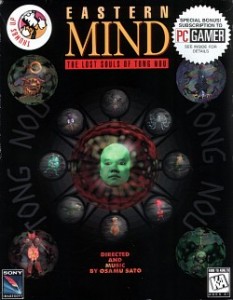Above on the screen of this Screening you can see, from Osamu Sato, one of the video game artists present at the exhibition “Devil Sun: Surviving Japanese Survival Horror”, his work “Eastern Mind: Lost Souls of Tong Nou”. Well, actually what you can see is a Full Playthrough, a video that shows how someone played the entire game. The real game can be enjoyed at La Posta Foundation.
“Eastern Mind: The Lost Souls of Tong Nou” (1994) is a point-and-click adventure game (played with the computer mouse). The plot follows a man named Rin, whose soul has been stolen by the island of Tong-Nou. Rin travels to Tong-Nou to recover his soul, acting out the lives of nine creatures. Each time Rin dies, the player chooses which creature Rin will be reincarnated as. The narrative structure of these types of stories allows them to take advantage of other media, such as literature and film, covering a wide variety of genres. In this case, the uniqueness of the story, together with that of many others that would come later, such as those produced by the other authors who also participate in this exhibition ―Kenji Eno and Kikiyama―, would lead critics and theorists of the medium to coin the expression “survival horror” (used for the first time with the release of “Resident Evil”), a style characterized by horror stories in which the player seeks survival. In the case of “Eastern Mind: The Lost Souls of Tong Nou”, Osamu Sato, who is the author of the graphics, music and development of the video game, goes so far as to create a world that has kept hundreds of thousands of players who have gone through its torment awake at night. The combination of its aesthetics, the development of the action, the perplexity generated by the questions that the program throws at the player, all in the midst of an immersive experience for which that music that you will never forget plays a major role, has made this video game deserve comments such as: “the strangest game we have ever played” (Tap Repeatedly); “one of the strangest and scariest games of all time”, further deeming it “self-indulgent”, “psychedelic”, “disturbing” and “niche” (Vice); the same outlet also noted that “the game is often derided as an example of the strangeness of Japanese culture, rather than highlighted as a testament to the blood, sweat, and tears Sato poured into his work”; Complex magazine included it in a list of the 10 strangest Japanese video games ever made, deeming it “a dark freak show”; Wired praised the game as an overwhelmingly surreal “Myst”-style experience, highlighting Sato’s simultaneously elaborate and childlike art design; Hardcore Gaming noted the difficulty of the puzzles proposed, due to the game being deliberately devoid of logic, a feature it accepted as a positive; Kill Screen felt that it was not really a game, but rather a window into the recesses of Sato’s mind; Biglobe felt that the characters were both unsettling and humorous, praising the sense of Eastern animism that permeated the experience; Rolling Stone suggested that the game instills an “initial tinge of disorientation [that] gives way to cultural vertigo”, as the Western player realises that, unlike in usual games where the enemy is killed, the protagonist has to die in order to progress.

“Devil Sun: Surviving Japanese Survival Horror” is an exhibition curated by Aitor de Maenza and Sergio Martín.

